Related Research Articles
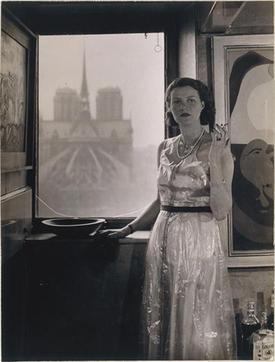
Marguerite "Peggy" Guggenheim was an American art collector, bohemian, and socialite. Born to the wealthy New York City Guggenheim family, she was the daughter of Benjamin Guggenheim, who went down with the Titanic in 1912, and the niece of Solomon R. Guggenheim, who established the Solomon R. Guggenheim Foundation. Guggenheim collected art in Europe and America between 1938 and 1946. She exhibited this collection as she built it. In 1949, she settled in Venice, where she lived and exhibited her collection for the rest of her life. The Peggy Guggenheim Collection is a modern art museum on the Grand Canal in Venice, Italy, and is one of the most visited attractions in Venice.

Helen Frankenthaler was an American abstract expressionist painter. She was a major contributor to the history of postwar American painting. Having exhibited her work for over six decades, she spanned several generations of abstract painters while continuing to produce vital and ever-changing new work. Frankenthaler began exhibiting her large-scale abstract expressionist paintings in contemporary museums and galleries in the early 1950s. She was included in the 1964 Post-Painterly Abstraction exhibition curated by Clement Greenberg that introduced a newer generation of abstract painting that came to be known as color field. Born in Manhattan, she was influenced by Greenberg, Hans Hofmann, and Jackson Pollock's paintings. Her work has been the subject of several retrospective exhibitions, including a 1989 retrospective at the Museum of Modern Art in New York City, and been exhibited worldwide since the 1950s. In 2001, she was awarded the National Medal of Arts.

Lyubov Sergeyevna Popova was a Russian-Soviet avant-garde artist, painter and designer.

Maria Helena Vieira da Silva was a Portuguese abstract painter. She was considered a leading member of the European abstract expressionism movement known as Art Informel. Her works feature complex interiors and city views using lines that explore space and perspective. She also worked in tapestry and stained glass.

Hildegard Anna Augusta Elisabeth FreiinRebay von Ehrenwiesen, known as Baroness Hilla von Rebay or simply Hilla Rebay, was an abstract artist in the early 20th century and co-founder and first director of the Solomon R. Guggenheim Museum. She was a key figure in advising Solomon R. Guggenheim to collect abstract art, a collection that would later form the basis of the Solomon R. Guggenheim Museum collection. She was also influential in selecting Frank Lloyd Wright to design the current Guggenheim museum, which is now known as a modernist icon in New York City.

Julie Mehretu is an Ethiopian American contemporary visual artist, known for her multi-layered paintings of abstracted landscapes on a large scale. Her paintings, drawings, and prints depict the cumulative effects of urban sociopolitical changes.
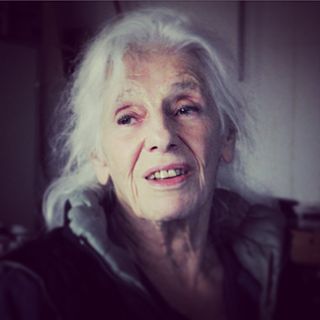
Josephine Gail Baer is an American painter associated with minimalist art. She began exhibiting her work at the Fischbach Gallery, New York, and other venues for contemporary art in the mid-1960s. In the mid-1970s, she turned away from non-objective painting. Since then, Baer has fused images, symbols, words, and phrases in a non-narrative manner, a mode of expression she once termed "radical figuration." She lives and works in Amsterdam, Netherlands.
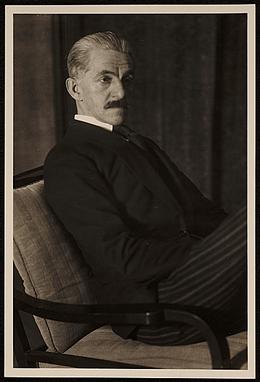
Alexander Georg Rudolf Bauer was a German-born painter who was involved in the avant-garde group Der Sturm in Berlin, and whose work would become central to the non-objective art collection of Solomon R. Guggenheim.
Alfred Julio Jensen was an abstract painter. His paintings are often characterized by grids of brightly colored triangles, circles or squares, painted in thick impasto. Conveying a complex web of ideas, often incorporating calligraphy or numerical systems, they are frequently referred to as "concrete" abstract art. After his death in 1981, the Guggenheim organized a major retrospective of his work, having held his solo exhibition there in 1961.

Miriam Schapiro was a Canadian-born artist based in the United States. She was a painter, sculptor, printmaker, and a pioneer of feminist art. She was also considered a leader of the Pattern and Decoration art movement. Schapiro's artwork blurs the line between fine art and craft. She incorporated craft elements into her paintings due to their association with women and femininity. Schapiro's work touches on the issue of feminism and art: especially in the aspect of feminism in relation to abstract art. Schapiro honed in her domesticated craft work and was able to create work that stood amongst the rest of the high art. These works represent Schapiro's identity as an artist working in the center of contemporary abstraction and simultaneously as a feminist being challenged to represent women's "consciousness" through imagery. She often used icons that are associated with women, such as hearts, floral decorations, geometric patterns, and the color pink. In the 1970s she made the hand fan, a typically small woman's object, heroic by painting it six feet by twelve feet. "The fan-shaped canvas, a powerful icon, gave Schapiro the opportunity to experiment … Out of this emerged a surface of textured coloristic complexity and opulence that formed the basis of her new personal style. The kimono, fans, houses, and hearts were the form into which she repeatedly poured her feelings and desires, her anxieties, and hopes".
Suling Wang is an internationally recognized painter and contemporary artist, known predominantly for her large scale abstract works. She currently lives and works in London, UK and Taichung, Taiwan.
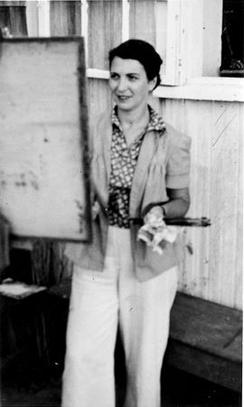
Perle Fine (1905–1988) was an American Abstract expressionist painter. Fine's work was most known by its combination of fluid and brushy rendering of the materials and the use of biomorphic forms encased and intertwined with irregular geometric shapes.

Girl with Ball is a 1961 painting by Roy Lichtenstein. It is an oil on canvas Pop art work that is now in the collection of the Museum of Modern Art, after being owned for several decades by Philip Johnson. It is one of Lichtenstein's earliest Pop art works and is known for its source, which is a newspaper ad that ran for several decades and which was among Lichtenstein's earliest works sourced from pop culture.
Sarah Crowner is an American painter best known for her geometric abstractions that evoke the style of hard-edge painting of the 1950s and 60s.
Woman Ironing is a 1904 oil painting by Pablo Picasso that was completed during the artist's Blue Period (1901—1904). This evocative image, painted in neutral tones of blue and gray, depicts an emaciated woman with hollowed eyes, sunken cheeks, and bent form, as she presses down on an iron with all her will. A recurrent subject matter for Picasso during this time is the desolation of social outsiders. This painting, as the rest of his works of the Blue Period, is inspired by his life in Spain but was painted in Paris.

Judit Reigl was a Hungarian painter who lived in France.
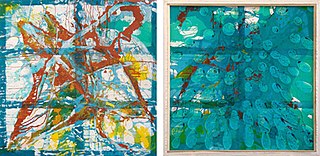
Dona Nelson is an American painter, best known for immersive, gestural, primarily abstract works employing unorthodox materials, processes and formats to disrupt conventional notions of painting and viewership. A 2014 New Yorker review observed, "Nelson gives notice that she will do anything, short of burning down her house to bully painting into freshly spluttering eloquence." Since 2002, long before it became a more common practice, Nelson has produced free-standing, double-sided paintings that create a more complex, conscious viewing experience. According to New York Times critic Roberta Smith, Nelson has dodged the burden of a "superficially consistent style," sustained by "an adventuresome emphasis on materials" and an athletic approach to process that builds on the work of Jackson Pollock. Writers in Art in America and Artforum credit her experimentation with influencing a younger generation of painters exploring unconventional techniques with renewed interest. Discussing one of Nelson's visceral, process-driven works, curator Klaus Kertess wrote, the paint-soaked "muslin is at once the tool, the medium, and the made."

Woman with Parakeet is a painting by Pierre-Auguste Renoir created in 1871. It is in the holdings of the Solomon R. Guggenheim Museum in New York as part of the Thannhauser Collection. The painting portrays model Lise Tréhot, who posed for Renoir in over twenty paintings during the years 1866 to 1872.

Judy Watson is an Australian Waanyi multi-media artist who works in print-making, painting, video and installation. Her work often examines Indigenous Australian histories, and she has received a number of high profile commissions for public spaces.
Susan Norrie is an Australian artist working primarily with found film and original video installations to explore political and environmental issues. In 2007 she represented Australia at the 52nd Venice Biennale.
References
- 1 2 3 4 5 6 7 "Biography | DENISE GREEN". www.denisegreen.net. Retrieved 11 April 2017.
- ↑ "New Image Painting". Oxford Reference.
- 1 2 3 4 5 6 Green, Denise (2001). Resonating: Denise Green. Brisbane. ISBN 0646412612.
{{cite book}}: CS1 maint: location missing publisher (link) - 1 2 3 Green, Denise (2005). Metonymy in Contemporary Art: A New Paradigm. Minneapolis: University of Minnesota Press.
- 1 2 3 4 Rumley, Katrina (1998). Denise Green. Craftsman House.
- 1 2 Marshall, Richard (1978). New Image Painting. New York. p. 26.
{{cite book}}: CS1 maint: location missing publisher (link) - ↑ Zabel, Barbara (May 2007). "An Interview with Denise Green". World Literature Today. 81: 55.
- ↑ "GREEN, Denise". It's an Honour. Retrieved 23 April 2017.
- ↑ Smith, Roberta (1987). "ART: EXXON SHOW AT THE GUGGENHEIM". The New York Times.
- ↑ Bell, Tiffany (1999). "Language and Intuition" (PDF). Art in America.
- ↑ "Million dollar gift to UQ pays tribute to Australian artist Denise Green". UQ News. Retrieved 21 April 2017.
- ↑ "Denise Green". Museum of Contemporary Art Australia. Retrieved 21 April 2017.